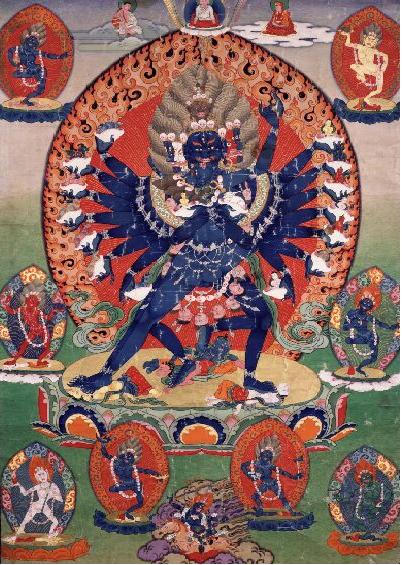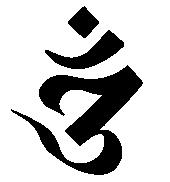|
Kilaya
In Tibetan Buddhism, Vajrakilaya (Skt. ''Vajrakīlaya''; Tib. རྡོ་རྗེ་ཕུར་པ་, ''Dorje Phurba'', Wyl. ''rdo rje phur pa'') or Vajrakumara (Skt. ''Vajrakumāra''; Tib. རྡོ་རྗེ་གཞོན་ནུ་, ''Dorje Shönnu''; Wyl. ''rdo rje gzhon nu'') is a wrathful heruka yidam deity who embodies the enlightened activity of all the Buddhas. His practice is known for being the most powerful for removing obstacles and destroying the forces hostile to compassion. Vajrakilaya is one of the eight deities of Kagyé. Vajrakilaya is a wrathful form of the Buddha Vajrasattva. His distinctive iconographic trait is that he holds the dagger called ''phurba'' or '' kīla''. Vajrakilaya is commonly represented with three faces of different colors in a crown of skulls. The central face is blue, the left is red and the right is white. He also has six arms: two holds the ''phurba'', two hold one ''vajra'' each, one holds a flaming snare, and one a trident. He ... [...More Info...] [...Related Items...] OR: [Wikipedia] [Google] [Baidu] |
Vajrakilaya (8557221604)
In Tibetan Buddhism, Vajrakilaya (Skt. ''Vajrakīlaya''; Tib. རྡོ་རྗེ་ཕུར་པ་, ''Dorje Phurba'', Wyl. ''rdo rje phur pa'') or Vajrakumara (Skt. ''Vajrakumāra''; Tib. རྡོ་རྗེ་གཞོན་ནུ་, ''Dorje Shönnu''; Wyl. ''rdo rje gzhon nu'') is a wrathful heruka yidam deity who embodies the enlightened activity of all the Buddhas. His practice is known for being the most powerful for removing obstacles and destroying the forces hostile to compassion. Vajrakilaya is one of the eight deities of Kagyé. Vajrakilaya is a wrathful form of the Buddha Vajrasattva. His distinctive iconographic trait is that he holds the dagger called ''phurba'' or ''kīla (Buddhism), kīla''. Vajrakilaya is commonly represented with three faces of different colors in a crown of skulls. The central face is blue, the left is red and the right is white. He also has six arms: two holds the ''phurba'', two hold one ''vajra'' each, one holds a flaming snare, and o ... [...More Info...] [...Related Items...] OR: [Wikipedia] [Google] [Baidu] |
Hevajra
Hevajra (Tibetan: kye'i rdo rje / kye rdo rje; Chinese: 喜金剛 Xǐ jīngāng / 呼金剛 Hū jīngāng;) is one of the main yidams (enlightened beings) in Tantric, or Vajrayana Buddhism. Hevajra's consort is Nairātmyā (Tibetan: bdag med ma). History India The Hevajra Tantra, a yoginītantra of the ''anuttarayogatantra'' class, is believed to have originated between the late 8th (Snellgrove), and the late 9th or early 10th centuries (Davidson), in Eastern India, possibly Kamarupa. Tāranātha lists Saroruha and Kampala (also known as "Lva-va-pā", "Kambhalī", and "Śrī-prabhada") as its "bringers": .. the foremost yogi Virupa meditated on the path of Yamāri and attained siddhi under the blessings of Vajravārāhi,...His disciple Dombi Heruka..understood the essence of the Hevajra Tantra, and composed many śāstras like the ''Nairātmā-devi-sādhana'' and the ''Sahaja-siddhi''. He also conferred abhiṣeka on his own disciples. After this, two ācāryas Lva-v ... [...More Info...] [...Related Items...] OR: [Wikipedia] [Google] [Baidu] |
Nāga
The Nagas (IAST: ''nāga''; Devanāgarī: नाग) are a divine, or semi-divine, race of half-human, half-serpent beings that reside in the netherworld (Patala), and can occasionally take human or part-human form, or are so depicted in art. A female naga is called a Nagi, or a Nagini. According to legend, they are the children of the sage Kashyapa and Kadru. Rituals devoted to these supernatural beings have been taking place throughout South Asia for at least 2,000 years. They are principally depicted in three forms: as entirely human with snakes on the heads and necks, as common serpents, or as half-human, half-snake beings in Hinduism, Buddhism, and Jainism. ''Nagaraja'' is the title given to the king of the nagas. Narratives of these beings hold cultural significance in the mythological traditions of many South Asian and Southeast Asian cultures, and within Hinduism and Buddhism, they are the ancestral origins of the Nagavanshi Kshatriyas. Etymology In Sanskrit, a () ... [...More Info...] [...Related Items...] OR: [Wikipedia] [Google] [Baidu] |
Bīja
In Hinduism and Buddhism, the Sanskrit term Bīja () ( Jp. 種子 shuji) (Chinese 种子 zhǒng zǐ), literally seed, is used as a metaphor for the origin or cause of things and cognate with bindu. Buddhist theory of karmic seeds Various schools of Buddhist thought held that karmic effects arose out of seeds that were latent in an individual's mindstream or psycho-physical continuum.Fukuda, Takumi. BHADANTA RAMA: A SAUTRANTIKA BEFORE VASUBANDHU, Journal of the International Association of Buddhist Studies, Volume 26 Number 2 2003. Rupert Gethin describes the theory thus: When I perform an action motivated by greed, it plants a 'seed' in the series of dharmas henomenathat is my mind. Such a seed is not a thing in itself - a dharma but merely the modification or 'perfuming' of the subsequent flow of dharmas consequent upon the action. In the course of time this modification matures and issues in a particular result, in the same way as a seed does not produce its fruit immediately, ... [...More Info...] [...Related Items...] OR: [Wikipedia] [Google] [Baidu] |
Akshamala
A japamala, , or simply mala ( sa, माला; , meaning 'garland') is a loop of prayer beads commonly used in Indian religions such as Hinduism, Jainism, Sikhism, and Buddhism for counting recitations when performing ''japa'' (reciting a mantra or other sacred sound) or for counting some other '' sadhana'' (spiritual practice) such as prostrating before a holy icon. They are similar to other forms of prayer beads used in various world religions and are sometimes referred to in Christianity as a "rosary". The main body of a mala is usually 108 beads of roughly the same size and material as each other though smaller versions, often factors of 108 such as 54 or 27, exist. A distinctive 109th "guru bead", not used for counting, is very common. Mala beads have traditionally been made of a variety of materials such as wood, stone, seeds, bone and precious metals—with various religions often favouring certain materials—and strung with natural fibres such as cotton, silk, or a ... [...More Info...] [...Related Items...] OR: [Wikipedia] [Google] [Baidu] |
Elephant
Elephants are the largest existing land animals. Three living species are currently recognised: the African bush elephant, the African forest elephant, and the Asian elephant. They are the only surviving members of the family Elephantidae and the order Proboscidea. The order was formerly much more diverse during the Pleistocene, but most species became extinct during the Late Pleistocene epoch. Distinctive features of elephants include a long proboscis called a trunk, tusks, large ear flaps, pillar-like legs, and tough but sensitive skin. The trunk is used for breathing, bringing food and water to the mouth, and grasping objects. Tusks, which are derived from the incisor teeth, serve both as weapons and as tools for moving objects and digging. The large ear flaps assist in maintaining a constant body temperature as well as in communication. African elephants have larger ears and concave backs, whereas Asian elephants have smaller ears, and convex or level backs. Elephants ... [...More Info...] [...Related Items...] OR: [Wikipedia] [Google] [Baidu] |
Trident
A trident is a three- pronged spear. It is used for spear fishing and historically as a polearm. The trident is the weapon of Poseidon, or Neptune, the God of the Sea in classical mythology. The trident may occasionally be held by other marine divinities such as Tritons in classical art. Tridents are also depicted in medieval heraldry, sometimes held by a merman-Triton. In Hinduism, it is the weapon of Shiva, known as ''trishula'' (Sanskrit for "triple-spear"). Etymology The word "trident" comes from the French word ''trident'', which in turn comes from the Latin word ' or ': ''tri'' meaning "three" and ''dentes'' meaning "teeth", referring specifically to the three prongs, or "teeth", of the weapo The Greek language, Greek equivalent is (''tríaina''), from Proto-Greek ''trianja'', meaning "threefold". The Greek term does not imply three of anything specific, and is vague about the shape, thus the assumption it was originally of "trident" form has been challenged. Latin ... [...More Info...] [...Related Items...] OR: [Wikipedia] [Google] [Baidu] |
Triratna
The Triratna ( pi, or ; sa, or ) is a Buddhist symbol, thought to visually represent the Three Jewels of Buddhism (the Buddha, the Dhamma, the Sangha). Symbol The Triratna symbol is composed of: * A lotus flower within a circle. * A diamond rod, or vajra. * An ananda-chakra. * A trident, or trisula, with three branches, representing the threefold jewels of Buddhism: Buddha, the Dhamma and the Sangha. On representations of the footprint of the Buddha, the Triratna is usually also surmounted by the Dhamma wheel. The Triratna can be found on frieze sculptures at Sanchi as the symbol crowning a flag standard (2nd century BCE), as a symbol of the Buddha installed on the Buddha's throne (2nd century BCE), as the crowning decorative symbol on the later gates at the stupa in Sanchi (2nd century CE), or, very often on the Buddha footprint (starting from the 1st century CE). The triratna can be further reinforced by being surmounted with three dharma wheels (one for each of th ... [...More Info...] [...Related Items...] OR: [Wikipedia] [Google] [Baidu] |
Blessing
In religion, a blessing (also used to refer to bestowing of such) is the impartation of something with grace, holiness, spiritual redemption, or divine will. Etymology and Germanic paganism The modern English language term ''bless'' likely derives from the 1225 term , which developed from the Old English (preserved in the Northumbrian dialect around 950 AD).Barnhart (1995:73). The term also appears in other forms, such as (before 830), from around 725 and ' from around 1000, all meaning to make sacred or holy by a sacrificial custom in the Anglo-Saxon pagan period, originating in Germanic paganism; to mark with blood. Due to this, the term is related to the term , meaning 'blood'. References to this indigenous practice, Blót, exist in related Icelandic sources. The modern meaning of the term may have been influenced in translations of the Bible into Old English during the process of Christianization to translate the Latin term meaning 'to speak well of', resulting in me ... [...More Info...] [...Related Items...] OR: [Wikipedia] [Google] [Baidu] |
Mudra
A mudra (; sa, मुद्रा, , "seal", "mark", or "gesture"; ,) is a symbolic or ritual gesture or pose in Hinduism, Jainism and Buddhism. While some mudras involve the entire body, most are performed with the hands and fingers. As well as being spiritual gestures employed in the iconography and spiritual practice of Indian religions, mudras have meaning in many forms of Indian dance, and yoga. The range of mudras used in each field (and religion) differs, but with some overlap. In addition, many of the Buddhist mudras are used outside South Asia, and have developed different local forms elsewhere. In hatha yoga, mudras are used in conjunction with pranayama (yogic breathing exercises), generally while in a seated posture, to stimulate different parts of the body involved with breathing and to affect the flow of prana. It is also associated with bindu, bodhicitta, amrita, or consciousness in the body. Unlike older tantric mudras, hatha yogic mudras are generally inte ... [...More Info...] [...Related Items...] OR: [Wikipedia] [Google] [Baidu] |
.jpg)




_colourised.png)

.jpg)
